- Joined
- 23 August 2011
- Messages
- 1,603
- Reaction score
- 4,740
I was only talking about powered guided weapons, freefall weapons and rockets would need a whole other list...timmymagic
You forgot the JDAM
Italian IDS
I was only talking about powered guided weapons, freefall weapons and rockets would need a whole other list...timmymagic
You forgot the JDAM
Italian IDS
I'm highly interested in the 3 view of this GAFAD version!1.) The book "Der Eurofighter" from Bernd and Ulrich Vetter included a 3 side view of the GAFAD version of the Tornado. I can take a picture from the book, if wanted. It was essentially new new aircraft compared to the Tornado, smaller, lighter, single seat, with fixed strake wings reprofiled and smaller fin and tailplanes, a single semi-circular airintake mounted beneath the fuselage and the RB.199s mounted vertically as on the Lightning, but with the lower engine mounted further forward to allow a thrust deflector plate to be installed beneath the rear fuselage for improved STOL performance. It was one of the last development proposals for a new fighter aircraft from MBB, but wind tunnel tests weren't promising and MBB went ahead with new designs such as the ADF-80.
I'm highly interested in the 3 view of this GAFAD version!
Thx for posting!Here it is. There is also a mentioning of the PANNAP studies (Panavia New Aircraft Project) and a brief description, but no images or drawings.
Thx for posting!
Now that's an interesting air intake design!
It actually looks like a dual intake with separate throats. The lower engine is fed by the inner intake and the duct is pretty straight. The upper engine is fed by the outer intake where the duct transitions from a ring to a circle. It is quite unusual.Could imagine that a single inlet for two engines isn't the best solution for air supply stability,
I don't suppose any technical details were ever released?
Such as size and thrust?
It's certainly considerably smaller than the TF30.
The advert implies it is in "the 10 000lb class", the same as the TF30 P6.. but that engine model actually pushed out 11250lbs.
I was wondering whether P&W were aiming for a non afterburning JTF16 for the MRCA, but with a higher dry thrust than the RB199?
KSL (Kombiniertes Scheinziel) was a German project for a powered IR-decoy for the Tornados.
It was supposed to fool modern flare-proof MANPADs using a rocket motor that let it continue the original trajectory of the Jet, which would turn away. The rocket exhaust was also supposed to mimic the emission spectrum of the jet exhaust. In the concept drawing a tube with multiple decoys is mounted next to the BOZ 101 flare pod.
The Tornado mid- life update (MLU), Staff Requirement (Air) 417, had its genesis in the mid-1980s and was created because the Tornado GR1's survivability in penetrating heavily defended Warsaw Pact airspace at low level needed to be improved. The Tornado's primary task was in the tactical nuclear-strike role, to deliver the WE177 free-fall bomb against pre-assigned Warsaw Pact targets.
The RAF, in the nature of upgrade projects, started by looking at what was possible, including the insertion of an airframe fuselage plug to provide extra fuel capacity, before narrowing its wish list down to the probable, and then finally to what is now referred to as MLU88.
The service had planned to order 26 new-build GR4s, as well as converting the bulk of its Tornado fleet, as its batch eight procurement, but this was cancelled in 1990.
Penetration capability
The driver behind the MLU 88 upgrade was to provide a fully automated, covert, low-level-penetration capability.
In addition to an improved avionics architecture, new displays and sensors were included - including a forward-looking infra-red (FLIR), new armament and control, and terrain-reference navigation (TRN) systems and covert radio altimeter. The additions of the FLIR and TRN were intended to allow the Tornado to be flown at low level without the necessity of using any active emitters - primarily the terrain-following radar (TFR).
The FLIR is limited, however, in having a forward field of view only, so it was supplemented with night-vision goggles (NVGs) and a compatible cockpit.
Subsequent events and ensuing budgetary constraints then conspired against the MLU 88 programme, however, after the components of the update had been chosen.
The underlying rationale for the MLU 88 was built on the premise that the RAF's primary mission would be to fight a war in the Central European theatre against Warsaw Pact forces. In addition, the 1990-1 Gulf War provided the service with a taste of the kind of future air operations with which it was likely to be tasked.
The MLU programme also became ensnared in the then Conservative Government's apparently rolling defence reviews, with Treasury officials viewing the project as a "big, big target". This resulted in a much-reduced scope for the MLU, the most visible element to suffer being the GEC Spartan TRN, which was deleted from the programme. Originally costed at around £1 billion ($1.6 billion), the eventual budget was cut to £750 million.
Ditching the TRN deprived the GR4 of an all-weather, night-covert-penetration capability because the FLIR is weather dependent, while the NVGs require adequate ambient light. Given certain conditions, a GR4 crew will have to resort to the active-emitter TFR to prosecute a mission at low level.
Would make sense for the interim anti-radar missile capability. Not seeing the TV pod, but I guess that would take the place of the outboard ECM/chaff pod.
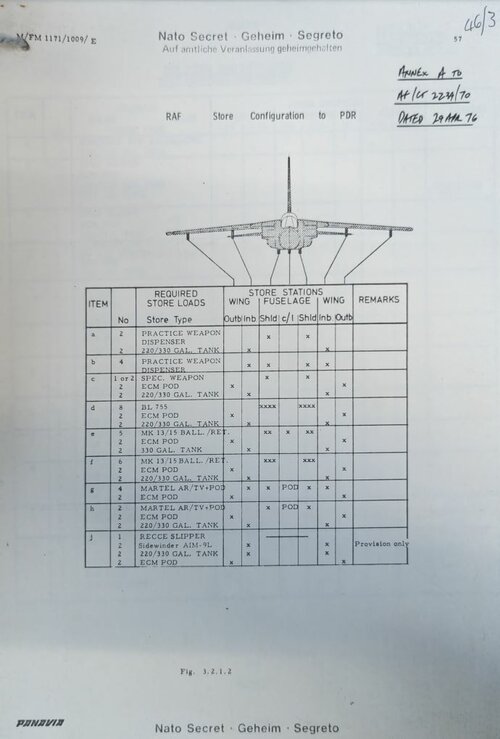
I finally found an answer to this. It seems the datalink pod was to planned to go on the centreline pylon, with Martel missiles on the shoulder pylons and inner wing pylons. I'm assuming Martel integration was dropped at some point though, as I've never seen it fitted to a Tornado.
Image from AIR 2/19035 at the National Archives
Yup, it's in my next book.The last item is interesting -- the RECCE SLIPPER sounds like a conformal reconnaissance system that would fit across the belly of the aircraft, occupying both the centerline and shoulder stations. Anyone heard of this before?
Yup, it's in my next book.
Chris
Was this reconnaissance slipper pod intended to carry the X-Band Synthetic Aperture Radar tested on Canberra WT327 in the 1970s?

The options include EFA produced on a 4-nation, 3-nation and single-nation basis with various numbers of squadrons; an off shore procurement of US F-15E, F-18E and F-22 aircraft mixed with a run on of Tornado F3 aircraft; upgrades of the Tornado F3 fleet to various levels of sophistication; co-production of the Rafale with the French and finally a mixture of a limited buy of EFA with a run on of Tornado F3.
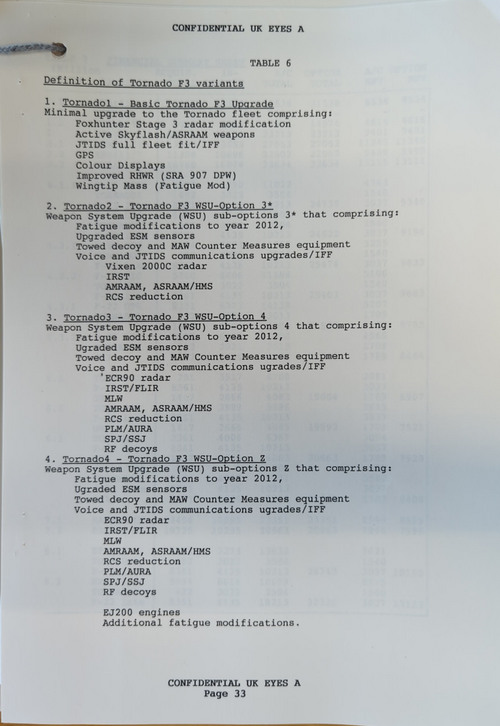
PLM = ? Precision Location?
AURA = ? AUtomatic Recovery of Aircraft maybe?
PLM usually means Product Lifecycle Management, but I'm not sure why only certain upgrade levels would have that -- it's kind of essential. Maybe some sort of automated on-aircraft PLM tracking system (AURA?)
As far as I know in the context of Tornado's radar PLM stands for "Pilot Lock Mode", a mode which lets the pilot quickly lock on to a target during a dogfight (basically the pilot presses a button and radar locks onto whatever is in front of it, rather than the navigator having to select the target on the radar screen and lock it that way). Seems a little strange to list that it a feature though, as Foxhunter had it from the very begining. Maybe it means something else in this context. Or perhaps ECR-90 didn't have that mode originally and it was planned to be added (it seems unlikely that such a basic feature wouldn't be included though).
On the Tornado F.3 AURA stood for "Alternative Use of Radar Antenna". This was a modification made to the AI.24 Foxhunter during Operation Granby which made it possible for the pilot to connect one of the radar's two Traveling Wave Tubes to a noise generator, allowing for the radar to be used as a stand off jammer. Presumably they had something similar planned for ECR-90 in the proposed upgrades.
That is a really slick trick!On the Tornado F.3 AURA stood for "Alternative Use of Radar Antenna". This was a modification made to the AI.24 Foxhunter during Operation Granby which made it possible for the pilot to connect one of the radar's two Traveling Wave Tubes to a noise generator, allowing for the radar to be used as a stand off jammer. Presumably they had something similar planned for ECR-90 in the proposed upgrades.


Is there any more information about the Sea Eagle being cleared on the Tornado ADV? One of the prototypes of that aircraft was given two additional hardpoints if I recall, in order to test certain elements of the proposed version for Japan, so they seemed to be quite serious about Tornado at one point. Is there any information about that aircraft as well?1987 proposal. Tornado ADV cleared for Sea Eagle, ALARM and bombs. Offered to export customers and RAF for Buccaneer replacement. Stopped in 1988.
Tornado J
1987 proposal to Japan's FS-X program. Based on ADV airframe with features from IDS and ECR.
Is there any more information about the Sea Eagle being cleared on the Tornado ADV?
The brief discussion in the paper of the F.3 Weapon System Upgrade is also quite interesting - comparing to your Post #139 above, it seems to correspond to Option 3* from that study, suggesting that may have been a preferred capability.I've attached a 1989 paper from the National Archives (part of AIR 8/3959) which discusses the merits of each aircraft and concluded that the Tornado GR.4 was the best option to replace the Buccaneer. So I doubt the RAF put any serious effort into integrating Sea Eagle into the F.3. I'm not sure about any efforts for export customers though.
The only way it makes sense is if the outer wing pylons were to be used for weapons, IMO. I don't know the weight limits on them, but running new wiring has to be easier than wiring and plumbing.Does anyone know how it could have been done? Conformal centre line tank maybe?
AURA was around for TELIC and the EF3 and not GRANBY. For GRANBY we were lucky enough to get a working RADAR. As for the Pilot doing anything with the RADAR - that was the job of the Nav/WSO! If Biggles tried to touch the RADAR, then Biggles would get their fingers broken ;-)As far as I know in the context of Tornado's radar PLM stands for "Pilot Lock Mode", a mode which lets the pilot quickly lock on to a target during a dogfight (basically the pilot presses a button and radar locks onto whatever is in front of it, rather than the navigator having to select the target on the radar screen and lock it that way). Seems a little strange to list that it a feature though, as Foxhunter had it from the very begining. Maybe it means something else in this context. Or perhaps ECR-90 didn't have that mode originally and it was planned to be added (it seems unlikely that such a basic feature wouldn't be included though).
On the Tornado F.3 AURA stood for "Alternative Use of Radar Antenna". This was a modification made to the AI.24 Foxhunter during Operation Granby which made it possible for the pilot to connect one of the radar's two Traveling Wave Tubes to a noise generator, allowing for the radar to be used as a stand off jammer. Presumably they had something similar planned for ECR-90 in the proposed upgrades.
Thank you.Here it is. There is also a mentioning of the PANNAP studies (Panavia New Aircraft Project) and a brief description, but no images or drawings.
Only their fingers? A bit lame when there are far more valuable tools around........AURA was around for TELIC and the EF3 and not GRANBY. For GRANBY we were lucky enough to get a working RADAR. As for the Pilot doing anything with the RADAR - that was the job of the Nav/WSO! If Biggles tried to touch the RADAR, then Biggles would get their fingers broken ;-)
Fingers are easier to reach.Only their fingers? A bit lame when there are far more valuable tools around........
Any details on this? I poked around but couldn't even find a sketch!LVJ Tornado
1980 project. Tornado ADV fuselage with low set compound delta wing and short coupled canards on air intakes.
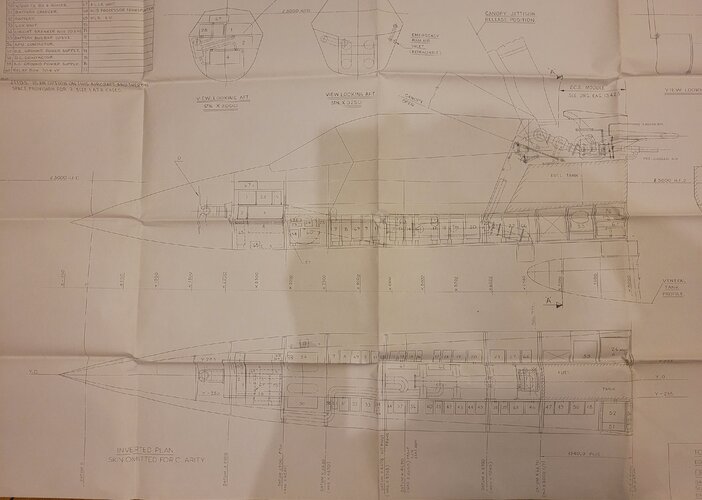
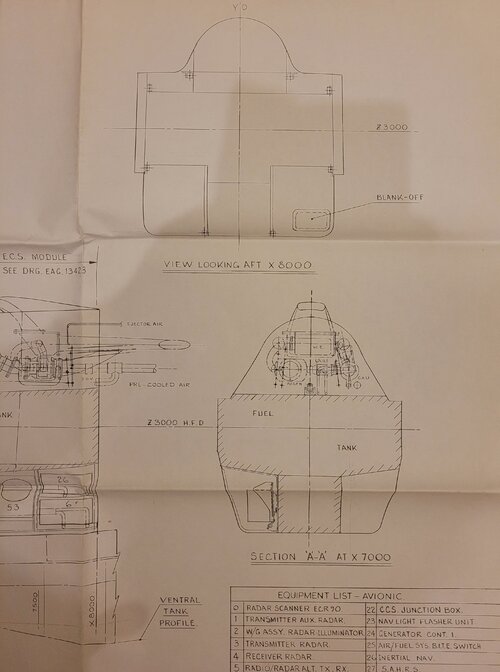
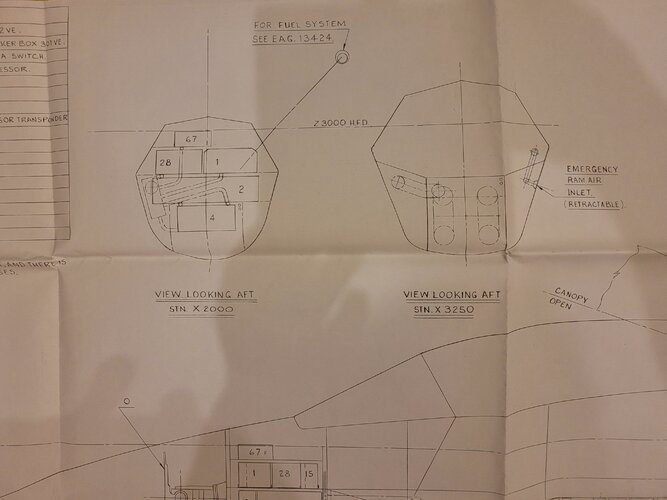
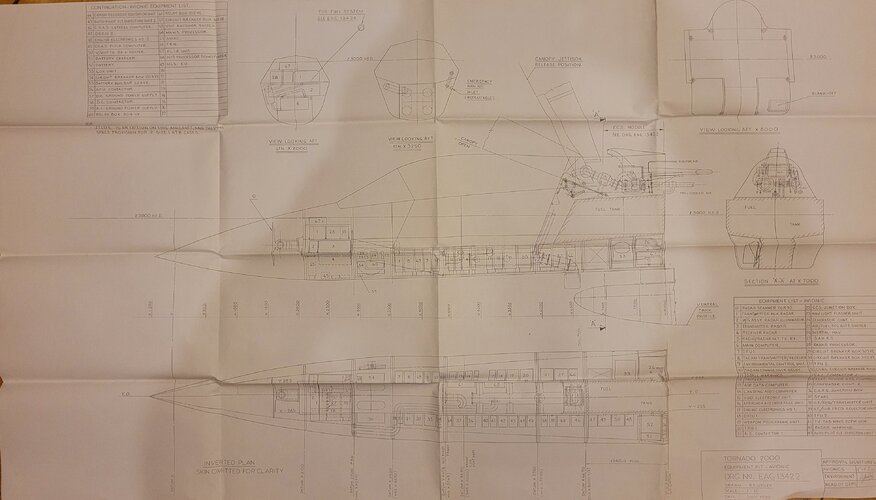
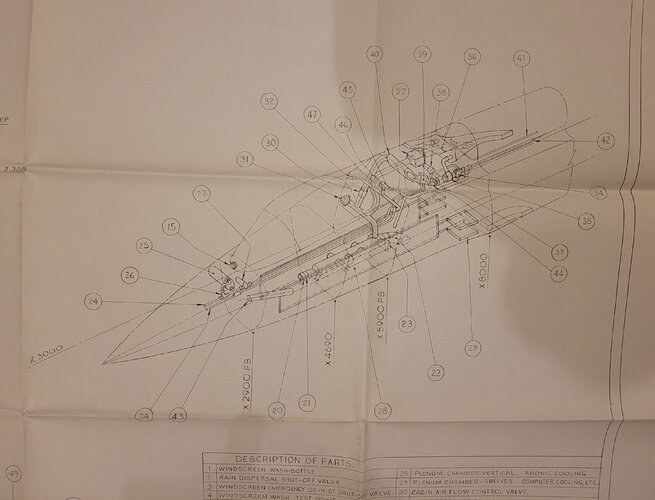
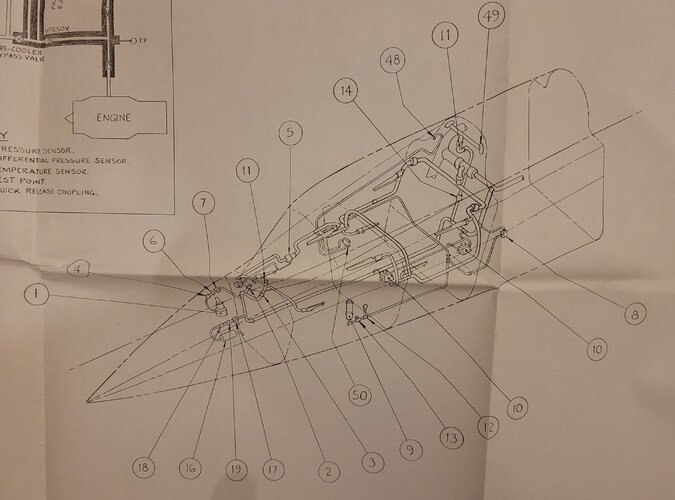
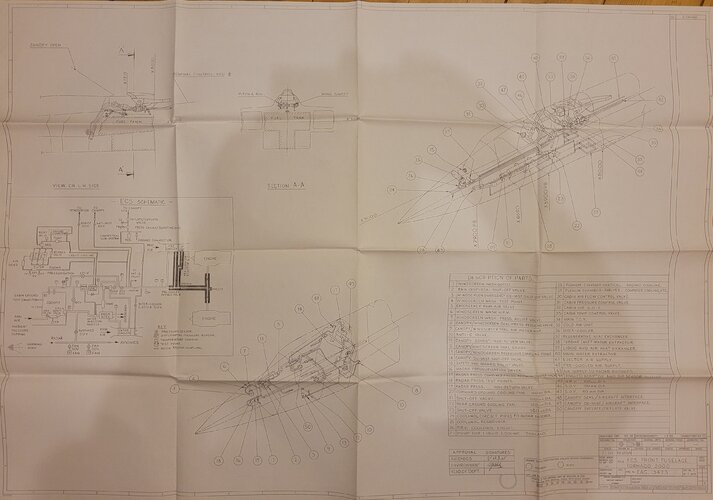
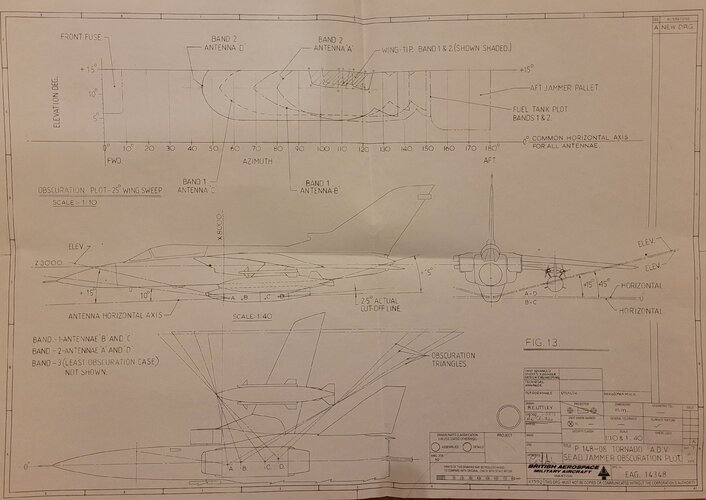
This need for maritime strike support was used as an argument against Winston Churchill when he was pimping out Freddie Laker's DC-10s.
Chris
